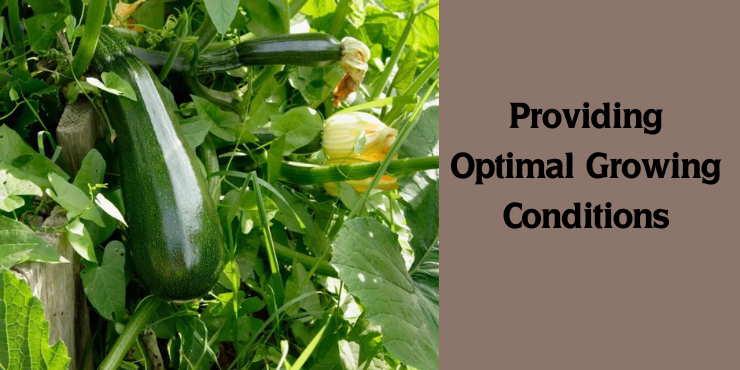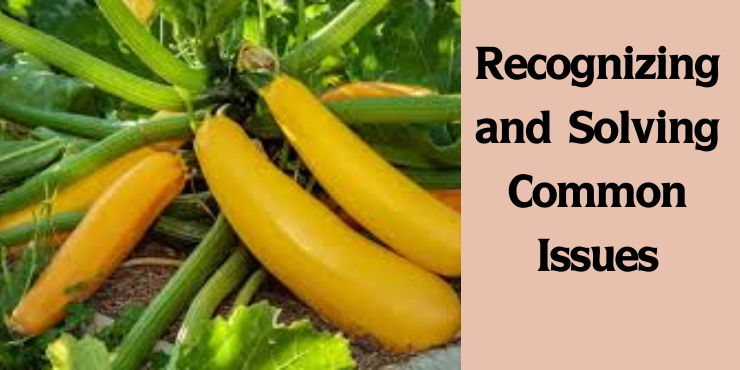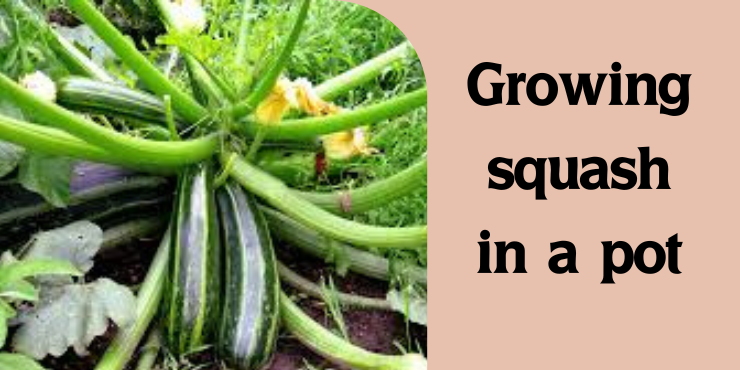Growing squash in a pot If you’re enthusiastic about gardening but find yourself lacking a large garden space, worry not! Growing squash in pot can be a rewarding endeavor that brings the joy of harvesting fresh vegetables to even the most limited spaces. In this comprehensive guide, we’ll walk you through the steps to successfully cultivate squash in pots, from selecting the right varieties to nurturing them into abundant harvests.
Table of Contents
- Introduction
- Choosing the Right
Growing Squash in a pot Varieties - Selecting the Ideal Pot
- Preparation and Potting Mix
- Planting Process
- Providing Optimal Growing Conditions
- Watering Wisdom
- Fertilizing for Vibrant Growth
- Managing Pests and Diseases
- Training and Supporting Vines
- Pruning for Productivity
- Recognizing and Solving Common Issues
- Harvesting Your Squash
- Celebrating Your Success
- Conclusion
Introduction
Growing squash in a pot brings the beauty of gardening to small spaces. Imagine plucking fresh zucchinis or butternut squash from plants thriving on your patio or balcony. With a bit of know-how and care, you can make this vision a reality. In this guide, we will explore the steps and tips for growing squash in a pot, so you can enjoy fresh, homegrown squash no matter how much space you have.
Choosing the Right Growing Squash in a pot Varieties
Choosing the Right Growing Squash in a pot Varieties” is a comprehensive guide that provides valuable insights and information to gardening enthusiasts seeking to cultivate squash in containers. Whether you have limited space or are simply looking to add a touch of greenery to your patio or balcony, this guide offers an extensive selection of squash varieties that can thrive and flourish in pots. The first step is selecting suitable squash varieties for container cultivation. Opt for compact and bushy varieties like Pattypan, Bush Acorn, or Spacemiser zucchinis. These types are well-suited to limited space and won’t overrun your container.
Selecting the Ideal Pot
Selecting the ideal pot is an essential aspect of gardening, whether it is for indoor or outdoor plants. The right pot provides the perfect environment for your plant to thrive and grow to its full potential. There are several factors to consider when choosing a pot, including size, material, drainage, and aesthetics. When choosing a pot, opt for one that’s at least 18 inches deep and wide. This provides ample room for the squash’s roots to spread comfortably. Make sure the pot has proper drainage holes to prevent waterlogging.
Preparation and Potting Mix
Preparation and potting mix is a specially formulated blend of organic materials designed to promote healthy plant growth. It is commonly used for both indoor and outdoor gardening, including container gardening and raised beds. Use a well-draining potting mix with a blend of compost, perlite, and coconut coir. Fill the pot, leaving a few inches from the rim. This nutrient-rich mix will provide a strong foundation for your squash plants.
Planting Process
Planting process refers to the step-by-step procedure followed in the planting of seeds or seedlings to establish a new plant or crop. It involves preparing the soil, selecting the appropriate seeds or seedlings, determining spacing and depth, and providing the necessary care for the plants to grow and thrive.
Plant squash seeds about an inch deep into the potting mix. If you’re using transplants, create a hole deep enough to accommodate the root ball. Space the plants according to the seed packet or transplant guidelines.
Providing Optimal Growing Conditions

Providing Optimal Growing Conditions refers to creating and maintaining an environment that is ideal for the growth and development of plants. This includes ensuring the right amount of light, nutrients, water, temperature, and humidity are provided to support plant growth. Place the pot in an area that receives at least 6 to 8 hours of sunlight daily. Squash plants love warmth, so ensure they’re in a sunny and sheltered spot.
Watering Wisdom
Watering Wisdom” is a comprehensive resource for anyone looking to improve their watering practices in their garden or landscape. Watering is a crucial aspect of plant care, and this guide provides valuable tips, techniques, and strategies to help gardeners water their plants effectively and efficiently. Keep the soil consistently moist but not waterlogged. Water the plants at the base to prevent leaf diseases. During hot spells, you might need to water more frequently.
Fertilizing for Vibrant Growing Squash in a pot
Fertilizing for Vibrant Growing Squash in a pot” is a comprehensive guide on how to effectively fertilize squash plants that are grown in containers. Squash plants have specific nutrient requirements to promote healthy growth and maximize fruit production, and this guide provides detailed instructions on choosing the right fertilizer, determining the correct amount to apply, and the optimum time to fertilize. It also offers helpful tips and techniques to ensure vibrant and vigorous growth of squash plants in pots, including maintaining proper watering and addressing common nutrient deficiencies. Whether you are a beginner or experienced gardener, this guide will provide you with all the information you need to successfully fertilize your squash plants and achieve a bountiful harvest.
Managing Pests and Diseases
Managing Pests and Diseases refers to the various practices and techniques employed to control and mitigate the negative impacts of pests and diseases on plants, animals, and humans. Pests and diseases can cause significant damage to crops, livestock, and ecosystems, leading to reduced productivity, economic losses, and potential health risks. Inspect your plants regularly for pests like aphids or squash bugs. If you notice any issues, consider using organic pest control methods to keep them in check.
Training and Supporting Vines
Training and supporting vines is an important aspect of gardening and landscaping. Vines, such as climbing roses, ivy, or grape vines, can add beauty and dimension to a garden or outdoor space. However, without proper training and support, these vines can become unruly and difficult to manage. Squash vines tend to sprawl, so provide support as they grow. You can gently guide the vines along a trellis or stake them to keep them off the ground.
Pruning for Productivity
Pruning for Productivity is a gardening guide and resource that focuses on the practice of pruning to increase productivity and yield in plants. This comprehensive book covers all aspects of pruning, including why it is important, when and how to prune different types of plants, and the benefits it can bring to the overall health and productivity of the garden. To encourage better airflow and fruit production, selectively prune the squash plants. Remove any dead or yellowing leaves and excess growth to focus the plant’s energy on producing delicious squash.
Recognizing and Solving Common Issues

Growing squash Recognizing and Solving Common Issues” is a comprehensive guide that provides essential information for successfully growing and maintaining squash plants. Yellowing leaves, blossom end rot, and powdery mildew are common issues that squash plants might face. Learn to identify and address these problems promptly to ensure a healthy harvest.
Harvesting Your Growing squash in a pot
If you have successfully grown squash in a pot, you are now ready to reap the rewards of your hard work. Harvesting your growing squash in a pot is a satisfying experience that allows you to enjoy the fruits of your labor. Before you start harvesting, it is important to know when your squash is ripe and ready to be picked. Harvest your squash when they reach a size suitable for their variety. Use a sharp knife or pruning shears to gently cut the stem. Regular harvesting encourages the plant to produce more fruits.
Celebrating Your Success
Celebrating Your Success Growing squash in a pot” is a detailed guidebook that highlights the joy and accomplishment of successfully growing squash in a pot. This comprehensive resource provides step-by-step instructions for selecting the right pot, preparing the soil, choosing the best squash variety for container gardening, and caring for the plant throughout its growth cycle. As your squash plants flourish and reward you with fresh produce, take a moment to celebrate your gardening triumph. Share your bountiful harvest with friends and family.
Conclusion
Growing squash in a pot is a delightful way to enjoy homegrown vegetables, even in limited spaces. With careful attention to detail and a touch of gardening magic, you can nurture your squash plants from seeds to scrumptious harvests. So, whether you have a small patio or just want to experiment with container gardening, growing squash in a pot is a rewarding and manageable option.
FAQs
- Can I grow different types of squash in the same pot?
- Yes, you can grow different squash varieties in the same pot, as long as they are compatible in terms of growth habit and size.
- Do squash plants need pollination to produce fruits?
- Yes, most squash plants require pollination to produce fruits. You can encourage pollination by attracting pollinators to your garden.
- What should I do if my squash leaves start turning yellow?
- Yellowing leaves can be a sign of nutrient deficiencies or diseases. Adjust your watering and fertilizing practices, and treat any potential diseases promptly.
- Can I use regular garden soil for growing squash in a pot?
- It’s best to use a well-draining potting mix instead of regular garden soil.
- Potting mixes provide better aeration and drainage for container plants.
- How often should I fertilize my squash plants?
- Fertilize your squash plants every 2 to 3 weeks with a balanced liquid fertilizer.
- Adjust the frequency based on the plant’s growth and the quality of the soil.
